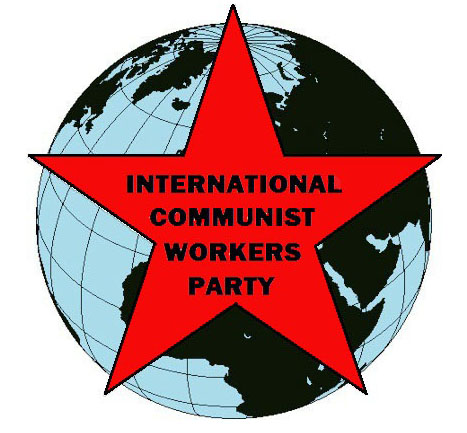
 |
FIGHT FOR COMMUNISM! |
International Communist Workers Party | |
|
| |
|
| |

The New York Times is considered the crown jewel of U.S. journalism. It hardly even mentioned the recent general strike of over 180 million workers in India.
It did, however, lead with a four-page article on the Indian Government’s plan to import cheap labor from villages surrounding Bangalore, India, an industrial city with about the same population as New York. The Sunday edition (9/25), the most widely circulated during the week, focused on a group of teenage women. They were “recruited” to fill the city’s garment sweatshops.
These 15-year olds were forced to do the same thing day after day, meeting back-breaking quotas. Their paychecks were delayed, causing them to go hungry for days.
Nonetheless, this bosses’ mouthpiece emphasized the “advantages” of this new (exploitative) life. The workers could now get mobile phones to talk to their boyfriends. They would no longer be subject to arranged marriages. The accompanying front-page picture showed them smiling as they read love letters from male co-workers. They had gained their independence, according to the Times.
The emancipating effect of “free labor” is a common lie used by capitalists the world over. Make no mistake about it, only communist production will free workers from the chains of wage slavery.
Many dedicated people have fought throughout the world to make capitalist production serve, at least in part, the interests of workers. Often this fight was organized by those who considered themselves communists. It has never worked, nor will it ever. Our energies are better spent mobilizing the masses directly for communism.
Some U.S. History
For a long time, U.S. garment workers have been subject to the “benefits” that capitalist industry provides. For example, tens of thousands of Mexican and Mexican-American workers were forced into sweatshops making clothes in California or shelling pecans in Texas after WWI. These mostly young women also came from rural areas and were brought to the brink of starvation.
They were not impressed with the “independence” of sweatshop labor. In fact, these recently proletarianized workers soon turned to collective fightback.
The established unions tried to sabotage class struggle. As William Z. Foster said in Towards Soviet America, when workers tried to use strikes to beat the wage cuts, they did their best to defeat them, using strike-breaking methods, among the worst of which were the fake strikes, or lockouts in the Socialist-controlled (as opposed to the Communist-led) needle trades.
The communists built “revolutionary unions” among garment workers and pecan shellers. The pecan shellers, like Texas garment workers, were mostly Mexican Americans who worked at home or in sheds without flush toilets or running water. In addition, the reds formed a “left” in the establishment unions.
The “revolutionary unions'' engaged in fierce class struggle, exposing the established union leaders and social democrats as agents of the bosses. They exposed the racist, xenophobic anti-working class New Deal. They united men and women of all races and nationalities. The long-term goal was to turn these unions into giant benevolent societies after a socialist revolution, like the unions in the Soviet Union.
These women strikers led by new Mexican-American communists were fearless. These leaders blamed racist, sexist super-exploitation on capitalism. But militant reform and even socialism held no answer in the end. Unions cannot be revolutionary no matter how militant.
Re-Thinking Our Strategy
The capitalist searches the world for cheaper labor. The 15-year-old super-exploited workers of Bangalore have common cause with the super-exploited Mexican and Mexican American workers who spurred the growth of the Communist Party after WWI in the U.S. Southwest.
From India to the U.S., that cause is to fight for communism. Only communist production can meet the needs of the working class. Nothing less will do.
Communist society will change the relations of production. Mobilized by a mass communist party, we will produce what we need. Profits have no role in communist production.
Capitalism must exploit workers lest the bosses make no profits. The bosses brag that the profit motive creates new products and keeps the factories humming. What a joke!
What really happens is that every capitalist floods the market with goods until the market is flooded with stuff workers can’t buy. Production collapses, sending millions to the unemployment lines.
In communism, the factories, mills, machines, etc. belong to us all. They are not owned by a few capitalists. Hence, communism can scientifically plan what to produce based on our needs.
There will be no markets. Each will get what they need, not what they can afford. No need for benevolent societies, union or otherwise!
Sweatshops will just be a horrible memory. We’ll put an end to monotonous, back-breaking drudgery. Every day will offer a new opportunity to expand our knowledge and creativity. Some days we won’t even make clothes.
We’ll create centers of production, which will also be centers of education. Social interaction will be based on common interests, not exploitation. Mental and manual labor will no longer be separated. The smiles will be real, based on our common desire to build communism for all.
The bosses create their own grave diggers when they ship 15-year-old teenagers into disgusting sweatshops. Long front-page puff pieces can’t change that reality.
These young Bangalore workers are part of a growing proletariat in India, where ICWP is growing. Like the Mexican and Mexican American women communists before them, they are the leaders we need.
Foster concluded Toward Soviet America saying, “The advance of revolution is difficult … and it varies from country to country, but its direction is sure and its movement irresistible.” It’s even more true today since we intend to make that revolution a direct fight for communism. Join Us!